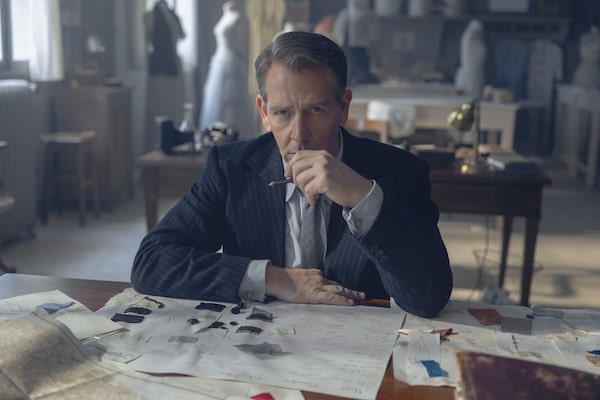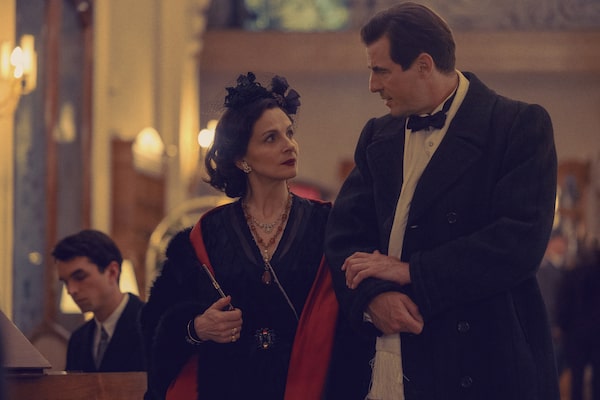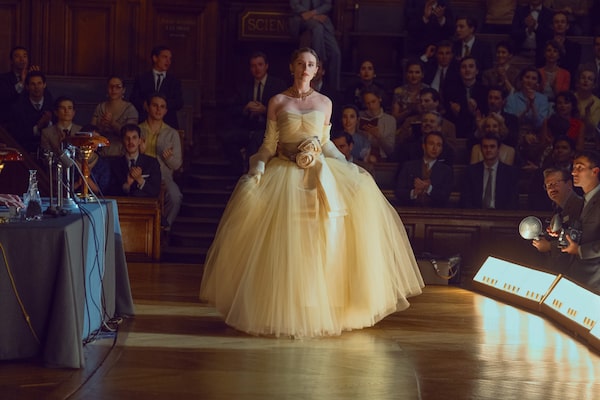
Ben Mendelsohn as Christian Dior in The New Look.Roger DO MINH/Apple TV+
What would you do to survive? Would you compromise your morals to save someone you love? When faced with an impossible choice, would you side with the enemy or sacrifice yourself? Those are the philosophical questions at the centre of Apple TV+’s The New Look, which goes deep into the dark histories of two of fashion’s most famous faces: Christian Dior and Coco Chanel.
The 10-part limited series stars Ben Mendelsohn and Juliette Binoche as the respective designers and traces their journeys in Nazi-occupied France and after the war. The two rarely intersect but are connected by world events that thrust them on unexpected trajectories.
At the time of the occupation, Dior is an up-and-coming designer working for Lucien Lelong (played here by John Malkovich). He is forced to design gowns for Nazis and their sympathizers under this arrangement, all while his sister Catherine Dior (Maisie Williams) operates with the resistance from his apartment. When Catherine is picked up and interrogated early in the series, Dior becomes desperate and obsessed with saving her.
Five new shows coming in 2024 worth renewing your streaming subscription for
Simultaneously, Chanel is a Parisian celebrity targeted by the Nazis, who are holding her beloved nephew, André Palasse (Joseph Olivennes), as a prisoner of war. History recalls her romantic relationship with a high-ranking German intelligence officer named Hans Günther von Dincklage (Claes Bang), and there’s evidence she was a Nazi intelligence operative and antisemite.
The separation of stories sometimes feels jarring, and you can’t help but want more scenes between these legendary figures and actors. Still, their journeys aren’t that far apart. Hope, fear and family motivate them both during unimaginable circumstances, and their stories live in that grey area for which character dramas such as these are made.
Dior is a creative genius who suffers without his muse, but although Mendelsohn plays him as a sympathetic underdog, he is willing to go to the dark side if it means bringing his sister home. Conversely, Chanel has found success, power and influence, but when her Jewish partners take Chanel No. 5 from her, she becomes determined to reclaim her life’s work.

Juliette Binoche as Coco Chanel and Claes Bang as Hans Günther von Dincklage.Roger DO MINH/Apple TV+
That juxtaposition makes The New Look an exciting exploration of privilege, power and the responsibility of those with a platform when society falls. Chanel’s influence on fashion is transcendent, from the little black dress to the perfume featured in the series. In exploring her history, are the creatives harming the brand, currently owned by the Wertheimer family, descendants of Chanel’s Jewish partners?
It’s a question worth asking, given the relevance of these stories today. The series raises questions about responsibility and the links between art and artist. Can you appreciate one without liking the other? Should we re-examine something previously cherished in the light of new information and the current context?
Creator Todd A. Kessler (Damages) said last week at the Television Critics Association Press Tour in California that he wasn’t interested in exploring the impact that telling these stories might have now. He said his sole focus was on the 1940s, the war and what these figures did back then. That means The New Look doesn’t try to answer questions and instead keeps the story planted in the circumstances and how people navigate them. Doing so allows viewers to make up their own minds while giving them new information to analyze.
The real missed opportunity for a series of this length is the underdevelopment of supporting players such as Lelong or Catherine Dior, whose contributions to the story are relegated to their interactions with Christian. Dior and his designs became a beacon of hope and joy for the French people after the war, but the show might have benefited from a deeper dive into those who influenced him and their motives. The actors embodying those roles certainly seem like they were ready to step up to the challenge, given what they do capture with their limited screen time.

The New Look is meant to inspire viewers to think beyond the art.Roger DO MINH/Apple TV+
The same is true for Chanel’s best friend, Elsa Lombardi (Emily Mortimer). Binoche and Mortimer’s scenes together are some of the most memorable of the series, and you want to know more about Elsa from the moment she appears onscreen. Unfortunately, the series also limits her portrayal to how she informs Chanel, although the ninth episode goes back in time to provide further context for their relationship.
Meanwhile, there are some extraneous scenes, particularly when it comes to the depictions of concentration camps, torture and Nazism. Although those moments are minimal, they do trigger trauma. Eliminating them and tightening up the story into eight even episodes instead of 10 instalments of varying lengths (run times range from 37 to 67 minutes) may have helped the overall pacing.
The bright spots are the period cinematography, which sucks you in with its scope and ambitious depiction of Paris, and the elaborate costumes, which bring it all to life. The costume department created roughly 70 pieces for the series, including recreations of the dresses from Dior’s historic 1955 collection shown at the Sorbonne and those from his 1947 solo debut, New Look.
Like the fashions featured in the series, The New Look is meant to inspire viewers to think beyond the art and learn more about these people after the final credits roll. In that respect, it’s a success, one that pushes past cancel culture to explore the nuances of people who have been backed into a corner and are facing an agonizing moral dilemma.
The New Look debuts with three episodes on Wednesday, Feb. 14, on Apple TV+.